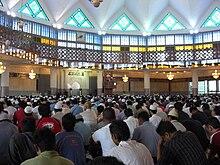National Mosque of Malaysia
| National Mosque of Malaysia | |
|---|---|
Masjid Negara Malaysia مسجد نݢارا مليسيا | |
 | |
| Religion | |
| Affiliation | Islam |
| Location | |
| Location | Kuala Lumpur, Malaysia |
| Geographic coordinates | 3°8′31″N 101°41′30″E / 3.14194°N 101.69167°E |
| Architecture | |
| Architect(s) | Howard Ashley, Ikmal Hisham Albakri and Dato Baharuddin Abu Kassim |
| Completed | 1965 |
| Specifications | |
| Capacity | 15,000 |
| Minaret height | 73 m (240 ft) |
| Website | |
| www | |




The National Mosque of Malaysia (Malay: Masjid Negara Malaysia; Jawi: مسجد نݢارا مليسيا) is a mosque in Kuala Lumpur, Malaysia. It has a capacity for 15,000 people and is situated among 13 acres (53,000 m2) of gardens. Its key features are a 73-metre-high (240 ft) minaret and a 16-pointed star concrete main roof. The umbrella, synonymous with the tropics, is featured conspicuously – the main roof is reminiscent of an open umbrella, the minaret's cap a folded one. The folded plates of the concrete main roof are a creative solution to achieving the larger spans required in the main gathering hall. Reflecting pools and fountains are spread throughout the compound. Completed in 1965, the mosque is a bold and modern approach in reinforced concrete, symbolic of the aspirations of a then newly independent nation.
History
[edit]Malaya gained its independence from the British government on 31 August 1957. Major development programs in areas of economy, social, and architecture were actively implemented in line with the new government. The programs were also implemented to portray new progressive culture and achieved democracy. Therefore, on 30 July 1957, in a meeting of the Federal Executive Council, an idea to build a national mosque as a symbol of the country's independence was mooted. In another meeting on 5 March 1958 of Chief Ministers of the eleven states in the Federation of Malaya, a proposal was made to name the mosque Masjid Tunku Abdul Rahman Putra Al-Haj, in recognition of Prime Minister Tunku Abdul Rahman's efforts in guiding the country to gaining independence. However, Tunku refused this honour; on the contrary, he named it Masjid Negara in thanksgiving for the country's peaceful independence without bloodshed.
The mosque was built on the former site of the Venning Road Brethren Gospel Hall, which was acquired by the government in 1961. The church was offered land on Jalan Imbi as a replacement and is now known as Jalan Imbi Chapel.[1] The original structure of the mosque was designed by a three-person team from the Public Works Department: UK architect Howard Ashley, and Malaysians Ikmal Hisham Albakri and Baharuddin Kassim. The engineer in charge of the construction of the mosque, which commenced in 1963 was Antony Morris. On Friday, 27 August 1965, the mosque was declared open by the third Yang di-Pertuan Agong, the late Tuanku Syed Putra of Perlis.
The mosque underwent major renovations in 1987, and the once-pink concrete roof is now clad in green and blue tiles. Today, Masjid Negara continues to stand sleek and stylish against the Kuala Lumpur skyline. An underground passage leads to the National Mosque located near the railway station, along Jalan Sultan Hishamuddin. Its unique modern design embodies a contemporary expression of traditional Islamic art calligraphy and ornamentation. Near the mosque is the Makam Pahlawan (Heroes' Mausoleum), a burial ground of several Malaysian Muslim leaders. Makam Pahlawan is a 7-pointed star concrete roofed structure.
The mosque was the largest in Malaysia until the completion in 1988 of the Sultan Salahuddin Abdul Aziz Mosque in Shah Alam.[2]
On 27 August 2015, Masjid Negara celebrated its Golden Jubilee (50th anniversary).
Imams of the National Mosque
[edit]- Ghazali Abdullah (1965)
- Mohs Salleh Hassan Farid
- Sheikh Abdul Mohsein bin Salleh (1974-1975)
- Ahmad Shahir bin Daud (1975-1980)
- Abu Hassan bin Din Al-Hafiz (1981-1983)
- Ahmad Shahir bin Daud (1984-1992)
- Arifin Harun (1992-1993)
- Taib Azamudden bin Md. Taib (1993-1999)
- A. Jalil bin Sindring @ Prangerang (1999-Sep. 2001)
- Wan Halim bin Wan Harun (2001-2004)
- Kamaruddin bin Zakaria (2005-2006)
- Tan Sri Dato' Sri Haji Ismail bin Haji Muhammad (February 2007 – 2019)
- Haji Ehsan bin Mohd Hosni (February 2020 – present)
Transportation
[edit]The mosque is accessible within walking distance of Kuala Lumpur railway station, served by the KTM Komuter, and Pasar Seni station, served by the Kelana Jaya and Kajang metro lines.
The free Go KL City Bus (Red Line) has a stop at Masjid Negara.[3]
See also
[edit]- Timeline of Islamic history
- Islamic architecture
- Islamic art
- List of mosques
- Islam in Malaysia
- Istiqlal Mosque, Jakarta — The national mosque of Indonesia
References
[edit]- ^ "Named after church leader". The Star (Malaysia). 27 September 2013. Retrieved 26 July 2020.
- ^ TourMalaysia.com, KL Heritage Trail: Masjid Negara−National Mosque, archived 4 February 2013, accessed 7 February 2024
- ^ http://www.spad.gov.my/sites/default/files/gokl_brochure_map-v3e_final-print.pdf Archived 17 May 2018 at the Wayback Machine [bare URL PDF]
